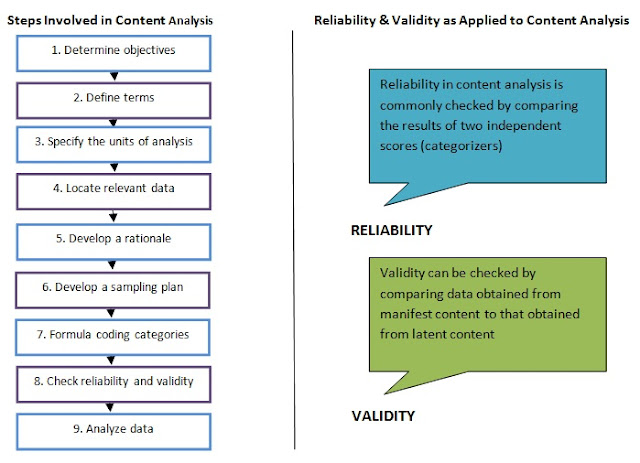On August 26, 2010 there was a presentation on "Qualitative Data Analysis" delivered by a group of Nor Farahida Nordin, Siti Maisara Unaizah Mustafa and Nasmila Rosli. The group covered on qualitative data analyses which consist of Content Analysis, Ethnographic Research and Historical Research.
CONTENT ANALYSIS
Content Analysis refers to a technique that enables researchers to study human behavior in an indirect way, though an analysis of their communication. Researchers often analyze textbooks, essays, newspapers, novels, magazine articles, cookbooks, songs, political speeches, advertisements, pictures and many other resources.
Data analysis – frequencies and proportion of particular occurrences to total occurrences are use to interpret content analysis data. In order to develop themes to facilitate synthesis, coding is used. Computer analysis is extremely useful in coding data once categories have been determined. It can also be useful at times in developing such categories.
Advantages of content analysis
· Unobtrusive – a researcher can ‘observe’ without being observed, since the contents being analyzed are not influenced by the researcher’s presence. Information that might be difficult, or even impossible, to obtain through direct observation or other means can be gained unobtrusively through analysis of textbooks and other communications, without the author or publisher being aware that it is being examined.
· Useful – as a means of analyzing interview and observational data.
· Able - to delve into records and documents to get some feel for the social life of an earlier time. He or she is not limited by time and space to the study of present events.
· Simple - logistics of content analysis are often relatively simple and economical with regard to both time and resources. (Newspapers, reports, books, periodicals).
· Available – data are available and almost always can be returned to if necessary or desired, content analysis permits replication of the study by other researchers. (Live TV programs can be videotaped for repeated analysis at later times).
Disadvantages of content analysis
· Limited to the analysis of communications and it is difficult to establish validity.
ETHNOGRAPHIC RESEARCH
Triangulation - Provide validity of an observation/ Can be implemented in any subjects, level and setting/Improves the quality of data and provide accuracy of interpretation/Occur in natural setting.
Patterns – Patterns in the way people think and behave/ Check ethnographic reliability when reveal the consistencies in what people say and what they do.
Key Events – Occur in every social group and provide data that can be used to describe and analyze an entire culture/Convey tremendous amount of information/View a culture.
Visual Representations – Maps (classroom or school), flow-charts (who say what to whom during a classroom discussion), organizational charts, Sociogram, matrices and others/ Help researchers to crystallize their understanding.
Statistics – Researcher uses nonparametric techniques (chi-square test)/ More likely to report frequencies than score.
Crystallization – No single stage or time when crystallization occurs/ Ethnographers pull together their thoughts at various stage throughout their research.
Advantages & Disadvantages of Ethnographic Research
Advantages: It provides a more comprehensive perspective than other forms of educational research/Lends to topics that are not easily quantified/Appropriate in studying behaviour in natural settings.
Disadvantages: Highly dependent on the particular researcher’s observations/Observer’s bias is almost impossible to eliminate/Generalization is practically non-existent.
HISTORICAL RESEARCH
From the data analysis aspect, historical research refers to the systematic collection and evaluation of data to describe, explain and thereby understand actions and events that occurred sometime in the past. As discussed in the classroom, there are five (5) purposes of historical research:
1. To make people aware of what has happened in the past so they may learn from failures and successes
2. To learn how things were done in the past to see if they might be applicable to present-day problems and concerns
3. To assist in prediction
4. To test hypotheses concerning relationships or trends
5. To understand present educational practices and policies more fully
Steps involved in Historical Research
Till then, thank you for reading! To get the Power Point slides, click







0 comments:
Post a Comment